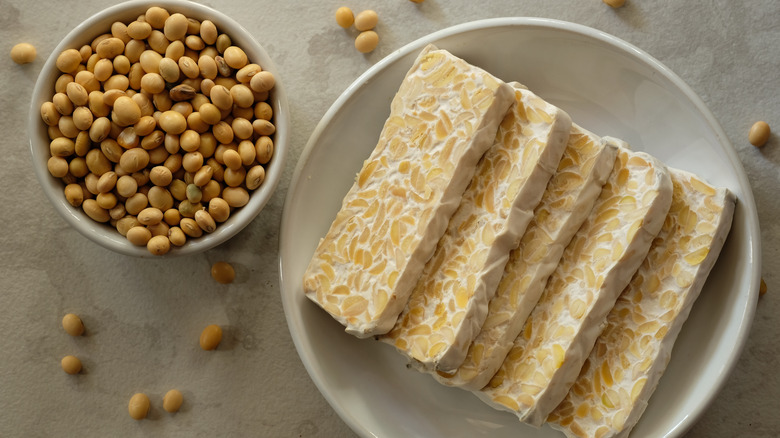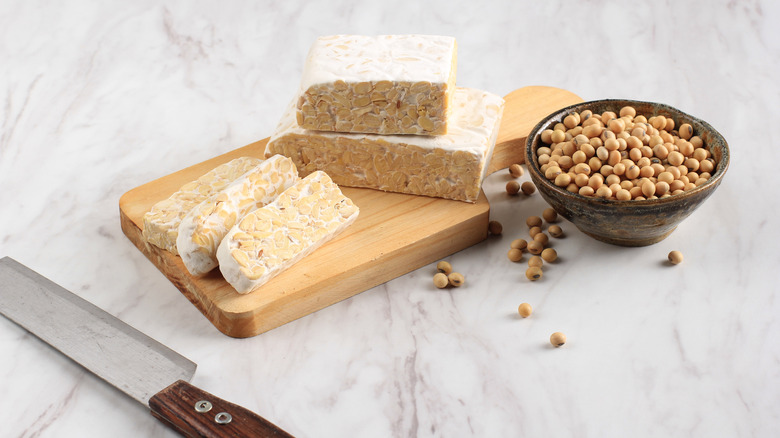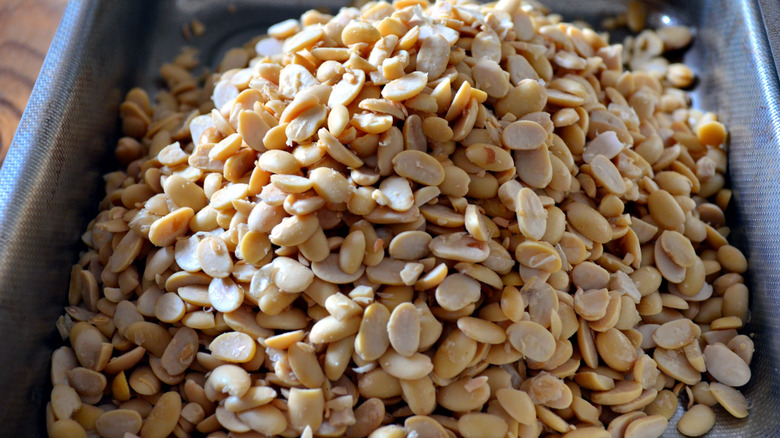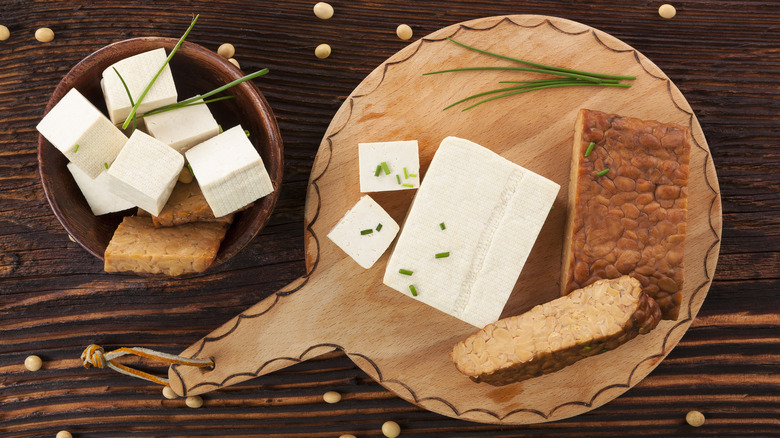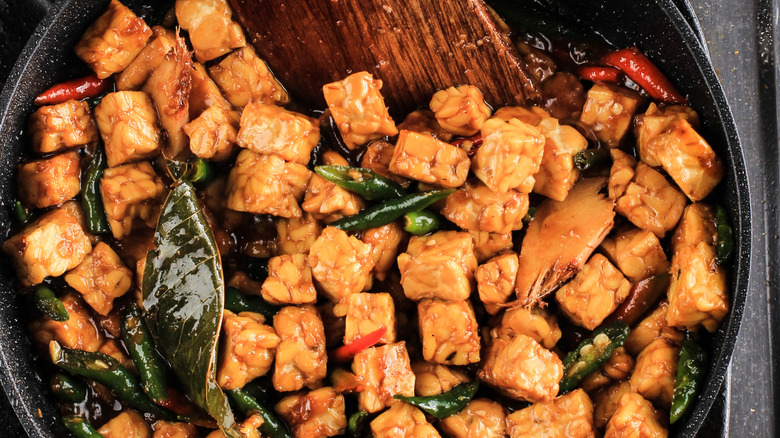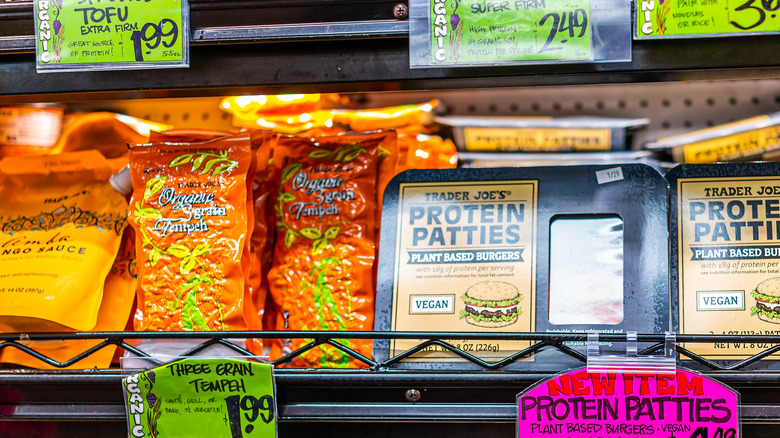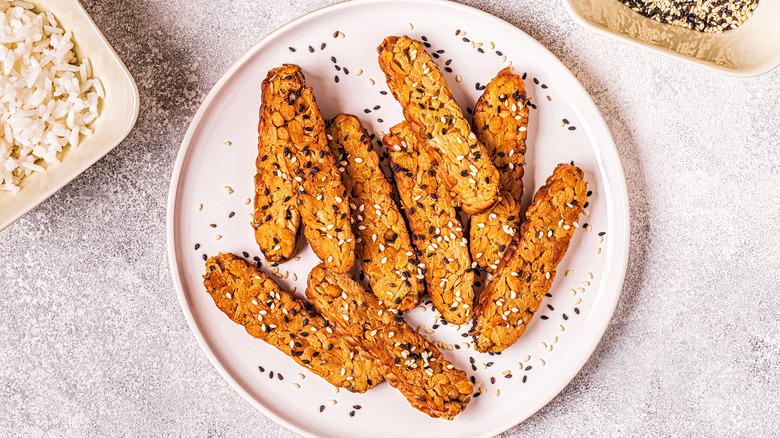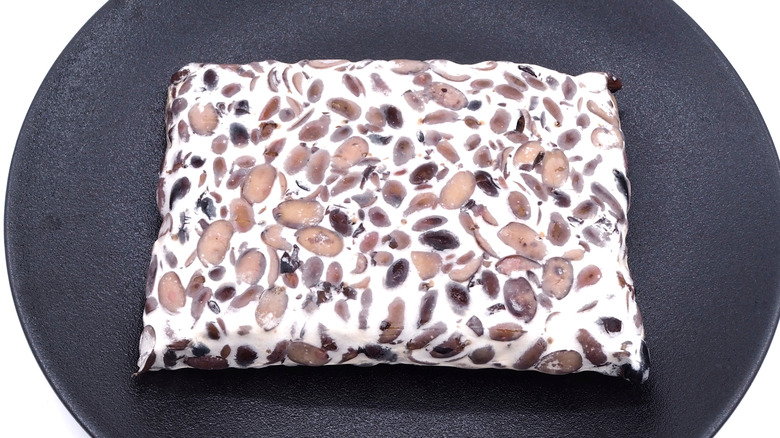What Is Tempeh And What Does It Taste Like?
Meat alternatives continue to be on the rise as the benefits of a plant-based diet for both humans and the environment are increasingly recognized. Though, traditionally, the most direct source of obtaining protein has come from animal sources, vegans and vegetarians have been supplied with more and more non-meat options over the years. And thankfully, we still have plenty to learn and borrow from cultures across the world that have been finding nutritious ways to eat balanced diets, with more plant-based foods, for centuries.
Take Indonesia, for example. For centuries and likely earlier, the local diet in this region (an archipelago between the Indian and Pacific Oceans) has included plenty of tempeh, says Soy Info Center. Originally known as témpé kedelé in Indonesia, this dense fermented soy protein source has since found its way to the West. Versatile, textured, and dare we say more exciting than tofu, tempeh is becoming a popular favorite among those looking for more protein-rich foods. If you've never tried it, it can be a tasty addition to your meatless Mondays — and you don't have to be a vegan to appreciate it.
What is tempeh?
Although tempeh can be made using a variety of legumes, the most common type is soy tempeh. Soy Info Center explains that, during the fermentation process, the action of the Rhizopus mold creates a thin encasing that holds individual soybeans together in a block formation. Tempeh is generally sold in a square slab about 1-inch thick, with the beige soybeans visible beneath a thin coat of fungus. While the thought of a fermented soybean cake might not elicit a mouthwatering response, the flavor when combined with other ingredients is downright delicious.
As mentioned, tempeh is fundamental to the Indonesian diet and is believed to have originated in the central east area of Java Island according to Soy Info Center. Tempeh.info further suggests that it may have been the first method of food processing on the island. While the first written reference only dates back to the 1800s, Soy Info Center states that tempeh was likely consumed for centuries prior. Unlike most soy products that come from China or Japan, Science Direct remarks that tempeh was not present in these countries, and instead was essential in the Indonesian diet.
During the colonization of Indonesia, the Dutch studied tempeh molds and began incorporating the fermented cake into their diets, eventually bringing it to Europe. After some research at Cornell University and other institutions fueled interest, tempeh began to be produced in the United States in the 1960s, says Tempeh.info. Business Wire currently estimates the value of the U.S. tempeh industry to be around $1 billion.
How is tempeh made?
As mentioned above, tempeh is held together by a mold. So, to make tempeh, you essentially have to create the perfect conditions for Rhizopus oligosporus mold to grow. If you're keen to try fermenting something new — perhaps you're already making your own kombucha – then growing your own tempeh could be a fun project. However, most consumers stick to purchasing it fermented and ready to cook.
Connoisseurus Veg details what you'll need to do to make your own batch. Soybeans (or another legume) are the core component, followed by rice vinegar or something else acidic, and tempeh starter. The starter is essentially some of the mold mixed with rice flour — you can even make your own once you get your first batch of tempeh going.
The soybeans will need to be soaked, removing as many hulls as possible. To help create a tighter block, the beans should be slightly squashed so that they split. Next, you'll cook the beans, dry them, and add them to a bowl with the vinegar and tempeh starter. If you've dabbled in fermentation before, you'll know that the right temperature is a key factor — Rhizopus mold likes to live around 85 to 90 degrees Fahrenheit with some ventilation. Once you've set up the ideal environment, the white fuzzy mold should begin to grow over the next 48 hours, covering the beans and binding them together in the process. At this point, the tempeh is ready to cook and serve.
Tempeh vs. tofu
While tempeh production is fairly simple, mostly relying on fermentation, tofu is a bit more complicated. Britannica explains that making tofu begins by soaking, crushing, and boiling dried soybeans to form a mixture with solid and milky components. Everyday Health further notes that coagulants are added to condense the milk, which is pressed into blocks of different densities to produce silken, semi-firm, and firm tofu.
Since making tofu separates the mass of the soybeans from the final product, it follows that tofu contains less protein and fiber than tempeh. For a 100 gram portion, tempeh boasts 20 grams of protein while tofu only has 8 grams, according to Well+Good. The source explains that tempeh also has more fat and calories per 100 grams, making it a nutritionally-dense option.
Due to the fermentation process to create tempeh, Healthline indicates that this food also contains prebiotics, a type of fiber that assists in healthy gut bacteria. While tofu isn't fermented, registered dietitian Sonya Angelone explains to Women's Health that the magnesium or calcium content can be greatly increased depending on which mineral is added during processing.
Tofu tends to be the more familiar soy product, making it easier to track down. When cooking, both options tend to take on the flavors of a dish, and can be used in numerous preparations. While tofu often gets a bad rap for being bland, tempeh can be an acquired taste. Nevertheless, both are great options for adding soy protein and texture to a dish.
What does tempeh taste like?
Fermented food often has a unique flavor, and tempeh is no different. The intensity increases as the tempeh matures, and blocks with more spots of gray mold will have a stronger taste than those that are uniformly white. Steer clear of pink, yellow, or blue mold, which indicates the tempeh is no longer safe to eat, according to Food & Nutrition.
Much like tofu, the specific cooking preparation used will largely dictate the taste of tempeh, since it absorbs the flavor of marinades and sauces. That being said, tempeh has a nutty, earthy taste that can vary from mild to strong, depending on the maturity. It also has a certain quality of umami, reminiscent of mushrooms. Tempeh often tends to be a divisive flavor, but it's worth trying in a few different dishes before ruling it out completely.
The texture of tempeh is also firm and chewy, which makes it a good meat substitute. When tempeh is deep-fried, a crispy shell develops on the exterior, contrasting nicely with the soft interior. Each method will enhance different characteristics, making tempeh very adaptable to the occasion.
How to cook with tempeh
Although tempeh can be used to create plenty of flavor profiles from many cuisines, it is worth experimenting with some Indonesian recipes or southeast Asian seasoning to understand its true origins. Thanks to its relatively firm consistency, though, tempeh can be prepared in dozens of ways, whether that's marinated and grilled or cubed and skewered. Love and Lemons suggests pan frying, deep frying (common in Indonesia), braising, and simmering tempeh for the best results. It can even be crumbled to mimic ground meat, or sliced into slabs and added to a sandwich or grain bowl. Tempeh also makes a reasonably convincing vegan bacon alternative when paired with liquid aminos.
Since tempeh doesn't have tons of flavor, it works well in saucy dishes or marinated before cooking. If marinating, Love and Lemons recommends first steaming it for ten minutes in order to improve the absorption and to remove any bitterness. They suggest to leave it in the marinade for a half-hour and bake at 425 degrees Fahrenheit for 20 minutes, flipping it halfway through.
You might also purchase tempeh that has been pre-cooked, in which case you don't have to cook it again. Nevertheless, you'll probably want to toss it into a sauce or sauté it until golden. While some people eat tempeh raw, either pasteurized or from a homemade batch, it is not recommended to do so. Soy Boy explains that the mold doesn't have any specific benefits, and during fermentation, undesirable microorganisms might have the chance to grow on it that should be cooked off first.
Where to buy tempeh
Thanks to the increasingly widespread interest among consumers both vegan and not, tempeh can be found in most supermarkets nowadays. Check in the refrigerated sections, either in the produce or natural food aisles of your grocery store. If they're selling tempeh, it will likely be sitting next to tofu and other soy-based or meatless products. It can also be found in health food shops, and perhaps even produced locally.
When choosing tempeh, check to be sure that there is no pink, yellow, or blue mold which means it is over fermented. Dark gray, black, or white mold is fine. You will notice that some tempeh is sold plain whereas other packages offer it pre-seasoned. If you want a low effort option, flavored tempeh will do the trick. Tempeh might also be sold as a burger patty or in strips as mock bacon. These are great ways to try it if you've never cooked with tempeh before.
Cooking Light recommends using tempeh within four to five days once the package has been opened. Otherwise, check the best before date on the label. Can You Freeze This confirms that tempeh keeps well in an airtight container or sealed bag in the freezer if you need more time to get to use it.
Nutritional information about tempeh
Tempeh is an excellent source of plant-based protein, and it is easier to digest than other soy food thanks to fermentation. The fermentation process breaks down phytic acids according to Healthline, which is beneficial since Harvard reports that phytic acids can impair mineral absorption. There are many vitamins and minerals in tempeh, including magnesium, manganese, phosphorus, iron, calcium, and potassium (via Healthline). Although tempeh has less calcium than tofu, one cup contains two-thirds the amount as one cup of milk. Tempeh is also high in B vitamins, which are less common in plant foods. Cooking Light also affirms that tempeh has poly- and monounsaturated fats and is high in fiber. Because of this, and together with the notable protein content, tempeh is a satiating option that may help manage weight.
While a lot of the excitement around fermented foods comes from probiotics, Healthline explains that these are eliminated when tempeh is pasteurized and cooked. Nonetheless, the source points out that tempeh is high in prebiotics, a form of fiber that promotes gut bacteria and may help decrease inflammation.
Soy has been the subject of debate for a long time, but according to Harvard it is safe to eat multiple times a week. The institution found neutral or positive effects on heart health, which was also noted in a 2004 journal study in Atherosclerosis concluding that soy protein lowers triglyceride levels. Since soybeans are a top eight common food allergen, those affected should look for tempeh made from other legumes.
Other varieties of tempeh
The most traditional form of tempeh is made from soybeans, but the same fermentation process can be applied to numerous legumes and grains to make a tempeh-like block. Chickpeas, black beans, jackbeans, and mung beans are some of the many traditional alternatives that can be used to make tempeh according to Tempe Bumbung. The production of tempe bongkrek, a Javanese variety made from coconut, has been prohibited by law since the 1970s due to the formation of a toxic component during fermentation (via Nature's Poisons). Thankfully you shouldn't come across it.
Besides the use of different legumes, Connoisseurus Veg notes that some tempeh might include extra seeds and grains such as flax, sesame, hemp, rice, and quinoa to add nutritional value and flavor. While tempeh is generally gluten-free, be sure to check the ingredients If you have allergies before purchasing or consuming it.
